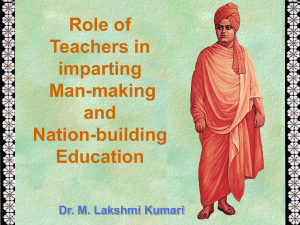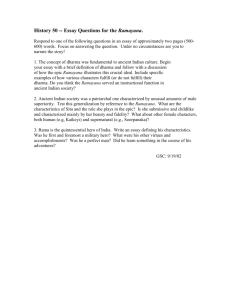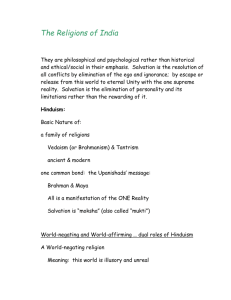sanatana dharma
advertisement
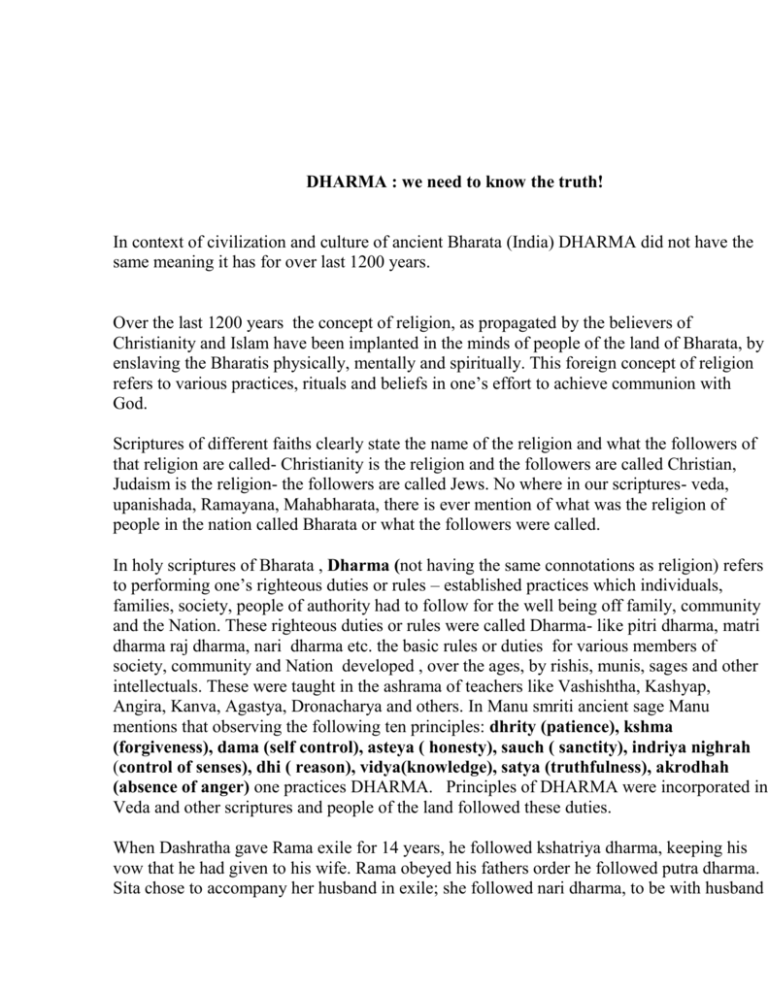
DHARMA : we need to know the truth! In context of civilization and culture of ancient Bharata (India) DHARMA did not have the same meaning it has for over last 1200 years. Over the last 1200 years the concept of religion, as propagated by the believers of Christianity and Islam have been implanted in the minds of people of the land of Bharata, by enslaving the Bharatis physically, mentally and spiritually. This foreign concept of religion refers to various practices, rituals and beliefs in one’s effort to achieve communion with God. Scriptures of different faiths clearly state the name of the religion and what the followers of that religion are called- Christianity is the religion and the followers are called Christian, Judaism is the religion- the followers are called Jews. No where in our scriptures- veda, upanishada, Ramayana, Mahabharata, there is ever mention of what was the religion of people in the nation called Bharata or what the followers were called. In holy scriptures of Bharata , Dharma (not having the same connotations as religion) refers to performing one’s righteous duties or rules – established practices which individuals, families, society, people of authority had to follow for the well being off family, community and the Nation. These righteous duties or rules were called Dharma- like pitri dharma, matri dharma raj dharma, nari dharma etc. the basic rules or duties for various members of society, community and Nation developed , over the ages, by rishis, munis, sages and other intellectuals. These were taught in the ashrama of teachers like Vashishtha, Kashyap, Angira, Kanva, Agastya, Dronacharya and others. In Manu smriti ancient sage Manu mentions that observing the following ten principles: dhrity (patience), kshma (forgiveness), dama (self control), asteya ( honesty), sauch ( sanctity), indriya nighrah (control of senses), dhi ( reason), vidya(knowledge), satya (truthfulness), akrodhah (absence of anger) one practices DHARMA. Principles of DHARMA were incorporated in Veda and other scriptures and people of the land followed these duties. When Dashratha gave Rama exile for 14 years, he followed kshatriya dharma, keeping his vow that he had given to his wife. Rama obeyed his fathers order he followed putra dharma. Sita chose to accompany her husband in exile; she followed nari dharma, to be with husband in good times or bad. Bhil Eklabya offered his severed right thumb to Dronacharya, he followed shishya dharma. Raja Harishchandra gave away his kingdom to the Brahmin practicing raj dharma and when he asked for a portion of coffin of his son Rohitashwa, he obeyed bhritya dharma. There are examples aplenty in our scriptures of individuals, communities, rishis, and people in authority following their righteous duties- their dharma. In which of the instances given above or any other similar instances do we find Dharma as something related to spiritual practice or related to God? Shrimadvagawad Gita is the gist of what Dharma is for an individual, for the family, community or nation as explained by Bhagawan Krishna. Two shlokas from Gita were heard by countless millions in Bharata, not only by the believers of Gita but by millions of people of other faiths when Mahabharata was transmitted on T.V., hardly a few of the believers understood what was the meaning of these shlokas. In these two shlokas Krishna gives clear meaning of DHARMA. yada yada hi dharmasya glanir bhavati bharata abhutthanam adharmaysa tadatmanam srijamyaham paritranaya sadhunam vinashaya cha duskritam dharma sansthapanarthaya sambhawami yuge yuge Does the word dharma here equate with English word religion? Is Krishna telling Arjun that the Pandava and Kaurawa were at war because all the people participating in the war had forgotten about God or they were not engaging in prayers or activities in regard to spiritual upliftment? “dharmasya glani” and “abjhuthanamadharmasya” make reference to decline in observance of righteous duties and increase in activities that were against the accepted principles of practice of dharma—setting lakshagriha on fire to kill Pandavas, attempting to disrobe Draupadi in public, not wanting to give mere 5 villeges to Pandavas, killing Abhimanu by maharathis when he had no weapon in his hands, killing all the children of Pandavas when they were asleep; torturing of rishis by rakhasas. abduction of Sita by Ravana—there are countless incidents in past yugas as examples of “dharmasyaglani’ and ‘abhuthanamadharmasya’. The presentation above, in summary, gives us the understanding that ‘Dharma’ is following one’s righteous duties and ‘adharma’ is engaging in activities that are contrary to Dharma. Dharma, in later period of our culture and civilization, was referred to as Vedic Dharma as the principles of Dharma were contained in our holy scriptures- Vedas. Sometimes, still later, our fore fathers referred these righteous duties as Sanatana Dharma because of our belief that our civilization, our culture, our Dharma have been there for infinite time through the cycle of four yuga- eternal, never ending. So how, we, the descendents of people from the time of king Bharata, and before him, according to our gotra, descendents of sages like Bharadwaja,Kashyapa, Bhrigu, Atreya, Kanva, Shampayana; have forgotten about our Dharma whether Vedic or Sanatana and call ourselves ‘Hindu’ and follow a religion called ’Hinduism’ ?

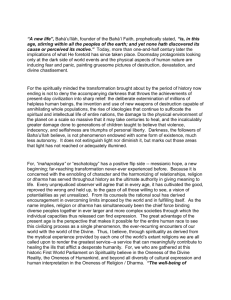
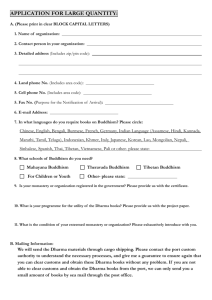

![[#SEAD-614] Create Project Space for Moore Lab Group](http://s3.studylib.net/store/data/007834021_2-e246955aacca9cfb92a906a1234e44a5-300x300.png)
